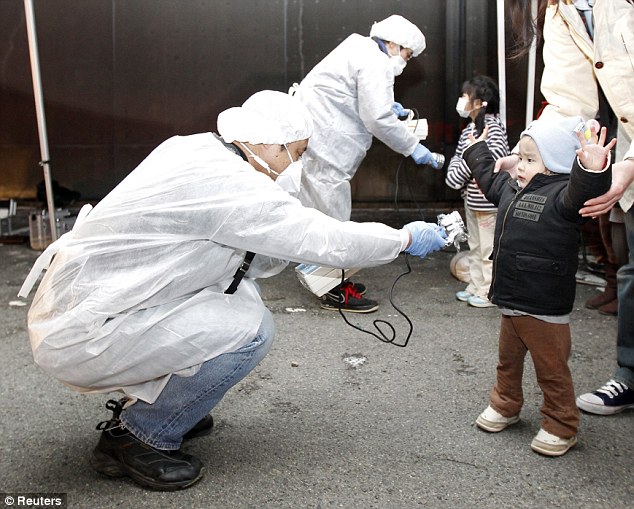【译注】这是一篇[爪译]的翻译文章,原文来自2011-3-14Medscape的 Robert Lowes,点这里查看英文原文Radiation Risks of Reactor Meltdown Both Short and Long Term.以下为中英对照译文。
</p>
在日本北部分发的碘化钾片,凸显了对日本福岛第一核电站熔毁的巨大灾难及致命放射性物质大量传播的恐惧,这对健康的造成影响,不仅危及于日本,也影响到它的邻国。
March 14, 2011 — The distribution of potassium iodide tablets in northern Japan underlines the fear of a catastrophic meltdown at the Fukushima Daiichi nuclear plant and the massive dispersion of deadly radioactive materials, with health implications for not only that country but also its neighbors.
在这场危机中,早先的报道称,3号反应堆过热所产生的辐射水平是低的、无害的。然而,如果反应堆里的核燃料从厚重的钢容器中泄露,辐射水平将飞涨。日本当地时间周二上午,2号反应堆——仅剩未爆的反应堆——附近传来爆炸声,这使得日本当局更加忧心忡忡。日本共同社报道了辐射量的激增,这更增加了对容器泄露的怀疑。
Earlier in the crisis, radiation emitted by the plant’s 3 overheating reactors was said to be at low, nonhazardous levels. However, radiation levels would skyrocket if the nuclear fuel in any of the reactors manages to escape its thick steel container. That possibility further worried Japanese authorities Monday evening EDT (Tuesday morning in Japan) when an explosion rocked reactor 2, the last of the units to blow. Kyodo News of Japan reported a spike in radiation, raising suspicions of a container breach.
“每个反应堆具有1000个广岛炸弹的放射性,“ 来自马萨诸塞州利兹的辐射暴露专家Ira Helfand医生说,他是医生对社会负责组织的董事会成员,提到了二战期间投在日本广岛的原子弹。
“Each reactor has the radioactivity of 1000 Hiroshima bombs,” said Ira Helfand, MD, an expert on radiation exposure in Leeds, Massachusetts, and a board member of the group Physicians for Social Responsibility, referring to the atomic bomb dropped on Hiroshima, Japan, during World War II.
发碘化钾药片是为了预防碘-131的辐射,放射性同位素碘可导致甲状腺癌。碘通常积聚在甲状腺,服碘化钾会使甲状腺事先达到饱和,从而抑制了对放射性碘的摄取。
The potassium iodide tablets were given out as protection against iodine-131, a radioisotope of iodine that can cause thyroid cancer. Iodine normally accumulates in the thyroid, so saturating the organ with a safe version by means of the tablets blocks the uptake of the radioactive version.
然而,核反应堆熔毁会导致其他危险颗粒的播散,它们都对身体有不利的影响,Helfand博士告诉Medscape: “锶-90可被骨吸收,从而导致癌症和白血病;铯-137会在体内播散,但更易被肌肉组织吸收。钚主要通过吸入产生毒性,会引起肺癌。”
However, a busted nuclear reactor can throw off other dangerous particles, each with its own adverse effects on the body, Dr. Helfand told Medscape Medical News. “Strontium-90 is absorbed by bone, which leads to bone cancer and leukemia,” he said. “Cesium-137 spreads throughout the body but favors muscle tissue. Plutonium is primarily toxic when inhaled and causes lung cancer.”
每种颗粒的半衰期长短也与风险有关。碘-131还算好,半衰期只有8天;锶-90,却有29年痛苦漫长的半衰期。
Each particle’s half-life also calibrates risk. For iodine-131, it is a mercifully short 8 days; for strontium-90, it is an agonizingly long 29 years.
急性放射综合症:症状的消退和复发
Symptoms of Acute Radiation Syndrome Subside, Return
辐射除了会造成癌症等的长期风险之外,还会造成短期危害。当人体的大部分或全部暴露于大剂量的辐射中达几分钟——核反应堆熔毁的可能结果——就会造成急性辐射综合症(ARS)。
In addition to long-term risks such as cancer, radioactivity can pose short-term risks. When most or all of the human body is exposed to a massive dose of radiation in a matter of minutes — a possibility with a nuclear reactor meltdown — the result is acute radiation syndrome (ARS).
急性辐射综合征的典型表现是:恶心、呕吐、腹泻,这些症状来得快,走得急,接着再次卷土重来,带来更大的打击,伴随着食欲降低、乏力、发热,更严重的可能会有抽搐和昏迷。根据美国疾病控制中心,若不能恢复,很多人会在数月内死去。多数人死于骨髓破坏引起的内出血和感染。
The first symptoms of ARS — typically nausea, vomiting, and diarrhea — hit immediately, subside, and then come back strong, accompanied by loss of appetite, fatigue, fever, and possibly seizures and coma. Most people who do not recover die within several months, according to the US Centers for Disease Control and Prevention. In most cases, death results from the destruction of bone marrow, which leads to infections and internal bleeding.
急性辐射综合征后随之而来的是辐射对皮肤的损害,或称皮肤辐射损伤。主要表现包括:短暂的瘙痒,皮肤针刺感和红肿。这些症状会在数小时、数天或数周内出现。同急性辐射综合征一样,皮肤辐射损伤的患者有数周到数月的潜伏期,当皮损再次出现,很可能是致命的。
A corollary to ARS is acute radiation damage to the skin, or cutaneous radiation injury (CRI). Symptoms such as transient itching, tingling, erythema, or edema can emerge within hours, days, or week. As with ARS, people with CRI usually experience a latent period of weeks to months. When skin lesions return, they can be debilitating or even life-threatening.
风向的转变是一个因素
Shifting Winds a Factor
作为预防措施,日本当局已经疏散了福岛第一核电厂附近城镇的大约十八万人,尽管截至日本当地时间周二上午,这些地区以外的辐射是危险水平的千分之一。日本也西风相助,风将少量的放射性物质吹向东边的太平洋。据美国核管理委员会,这些漂流的污染物不会对夏威夷、阿拉斯加或西海岸人的健康构成威胁,因为日本与美国远隔数千英里。
As a precaution, Japanese authorities have evacuated roughly 180,000 people from towns near the Fukushima Daiichi nuclear plant, even though radiation levels outside it as of Monday afternoon EDT were thousands of times below those considered dangerous. Japan also has benefited from westerly winds that have blown the small amounts of radioactive material east toward the Pacific Ocean. That drifting contamination does not pose a health threat to Hawaii, Alaska, or the West Coast, given the thousands of miles between Japan and the United States, according to the US Nuclear Regulatory Commission.
Rick Morin博士是美国放射学院安全委员会的主席,他解释说,从日本空中飘来的放射性物质,如同从烟囱里冒出的烟,飘的越远,带来的危害越小。在向东的过程中,大部分物质将落入海中。
Rick Morin, PhD, chair of the safety committee of the American College of Radiology, explained that airborne radioactive material from the Japanese reactors is like smoke from a smokestack, diffusing and becoming less harmful the farther it travels. Travelling eastward, much of it would fall into the sea.
不过,据天气预报预测,在日本北部的风力明天将转向,这意味着来自反应堆的放射性物质将会被吹回内陆。
However, weather forecasts predict that winds in northern Japan will reverse direction tomorrow, which means any radioactive material from the reactors would be blown inland.
在这种天气下,如果有反应堆熔毁并喷出大量的放射性颗粒,日本将不得不担心它降临到陆地所引发的食物链的污染。Morin博士说,在乌克兰切尔诺贝利核反应堆事件后,在孩子中爆发了甲状腺癌,这是因为他们喝的牛奶是来自吃了被碘-131污染的草的奶牛。
If a reactor meltdown spewed enormous quantities of radioactive particles in that weather scenario, Japan would have to worry about it coming down to earth and poisoning the food chain. Dr. Morin said thyroid cancer broke out among children after the meltdown of the nuclear reactor in Chernobyl, Ukraine, because they drank milk from cows that had eaten grass contaminated with iodine-131.

